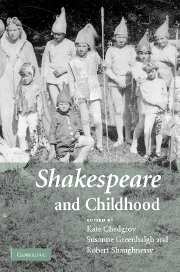1 - Children in Shakespeare's plays: an annotated checklist
Published online by Cambridge University Press: 22 September 2009
Summary
Children appear frequently in Shakespeare's plays. When one looks at efforts to account for the number of children in the plays, however, one immediately encounters disagreement. Thomas Pendleton asserts that ‘by the most liberal definition, there are only about thirty child characters in the … canon’. Mark Heberle's larger count finds ‘altogether thirty-nine child characters in the canon’ and my own reckoning comes in at about forty-five, not counting the choristers mentioned in Henry VIII. It is telling, I believe, that Pendleton, who claims that ‘Shakespeare's insight into the child's experience occurs only randomly’, sees fewer child figures than Heberle, who reminds us that‘the appearance of any children on the stage is unusual’ and suggests that the popularity of the boy actors in Elizabethan England reflected ‘a striking new interest in childhood and children within Elizabethan society’ and that a number of plays ‘posit a direct relation between social health and the welfare of children’.
Children in plays may evoke concerns about political stability, threats to authority, the continuity of community values, pregnancy and birth, processes of maturation, education, moral training, and employment experiences away from home. Because age-marked social boundaries, being in large measure culturally defined, are often in practice quite flexible, a child character represents a rather wide range of possibilities.
- Type
- Chapter
- Information
- Shakespeare and Childhood , pp. 233 - 249Publisher: Cambridge University PressPrint publication year: 2007
- 3
- Cited by

